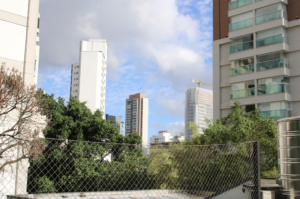
by Zoey Duan
Brazil has been called “a country of contrasts” by many. It is a country that cannot be described in few words –– a “beautiful mosaic.”
During my visit to São Paulo this summer, I realized that these are not empty praises. Even before I stepped foot onto its bustling streets, I remember flying over the Brazilian landscape, looking out the small, pill-shaped window and seeing that the city looked more like a homemade blanket, with patches of green, white, and brown stitched together, than anything else. Once I touched down, I found myself face to face with dozens of colossal high rises that stood amidst green clusters of tree canopies being cut down for construction, pristine marble entryways that laid steps away from the cracked concrete pavements, and glossy glass buildings just adjacent to angry graffiti art that decorated the streets of favela neighborhoods. I realized that the vibrant mix of colors is created by disparities that are much less beautiful than the halcyon they seemed to form.
Brazil has a prominent and visible socio-economic divide. According to a study by the University of São Paulo, the richest 1% –– most of which are white men –– own 28.3% of the country’s entire wealth. In contrast, the largest demographic group in Brazil –– Black and mestizo women –– have just 14.3%. One of the most dangerous effects of such disparities manifests in the health of the São Paulo people. Despite having a universal healthcare system in which healthcare is considered a constitutional right of the people, and in which health coverage is extended to every citizen, marginalized groups still face many public health issues.
For instance, over 100 million Brazilians lack access to proper sanitation infrastructure. Specifically, as of 2020 19.1% of households are connected to septic tanks but are not connected to a larger sewage system, where sewage can be collected and treated in a safe manner. About 12.6%, or 9 million households, use a ditch, rudimentary cesspit, river, lake, or the ocean as their main disposal site. This is coupled with the fact that over 15 million Brazilians in urban areas, and 25 million people in rural areas, do not have access to safe water that is protected from external contamination and available at, or close, to home. This lack of access leave countless people vulnerable to waterborne diseases, causing conditions, such as diarrhea, to be leading causes of death in the country.

On the other side of the coin, some of Brazil’s richest regularly visit what are known as “luxury clinics” that offer a wide range of specialty services, including medical spa treatments, nonessential cesarean birth operations, cosmetic surgeries, and more. Even for those who are not the ultra-rich, Brazil is home to some of the world’s most cutting-edge medical research institutions that double as public teaching hospitals. For example, the Instituto do Coração (InCor) and the Instituto do Câncer (ICESP) of the University of São Paulo Faculty of Medicine Clinics Hospital are both ranked among the world’s top specialized hospitals for cardiology and cancer respectively, according to Newsweek.
“We have the most modern technologies to treat cancers, and that’s great,” said Dr. José Ricardo Ayres, a physician and professor at the University of São Paulo. “But we also have around half of the population living in conditions that are similar to [the] Middle Ages.”
For decades, Dr. Ayres has worked in promoting primary and public health among Brazil’s most vulnerable. He believes that while much progress has been made since the late 1990s, when Brazil’s Unified Health System was still budding into existence, much more needs to come.
“In terms of impact, we have good results in our morbidity and mortality profile. We have reduced child mortality, expanded life expectancy, and we have gained more control over chronic problems of health risk, like diabetes,” he said.
In fact, up until recently, Brazil had been a model country in the global health sphere for improvements in vaccination and infant mortality rates In 2019, Brazil achieved 77.12% child vaccination coverage and 75% reductions in under-five mortality rate.
But since the start of the COVID-19 pandemic, Brazil has taken a staggering hit on these public health metrics. Battling infectious outbreaks, decreased federal support for public services, and misinformation, the country saw devastating death tolls and downturns in health outcomes. Many, including Dr. Ayres, point to the former Bolsonaro administration as the root cause of these issues.
“The federal government, with the leadership of Bolsonaro, neglected the risks,” Dr. Ayres said. He cited Bolsonaro’s national television appearances, during which the former president dismissed the dangers of the COVID-19 virus as a “flu” and showed himself walking about the streets without a mask, claiming that it “was not necessary.” Dr. Ayres remembers one time, during the height of the pandemic, when he had visited one of the biggest slums in outer São Paulo for a disease prevention program and found young people walking about without masks. “They said, ‘The president isn’t wearing a mask. Why should I?’”
The rhetoric of the Bolsonaro government also drove away other essential resources and partnerships, including 8,300 Cuban doctors serving in the More Doctors program, partnerships with international multilateral agencies such as the UN AIDS program, and more.
As a result, vaccination rates plummeted, and service shortages increased. In 2021, 26 percent of Brazilian infants received no vaccines, compared to just 13 percent in 2018. In their places, former president Bolsonaro promoted a “cocktail” of drugs as the antidote to the virus despite little scientific evidence to back up its effectiveness.
“They spent lots of money in producing this for essentially nothing… Fortunately, we had the unified health system so there was access throughout the country to have equipment and services, especially primary health care units.” Dr. Ayres said, “But we also lost a lot, because if we had central coordination, it would have been easier and cheaper to buy protection equipment and ensure the production of vaccines.”
One of Bolsonaro’s final pushes was his 2023 budget proposal for the health sector. The document detailed a reduction of R$22.7 billion reais, or $4.2 billion USD, in funding for public healthcare. While this proposal poses a major detriment to the public health system, others believe the change, coupled with increasing skepticism in the public healthcare sector, could give way to the growing private healthcare sector.
Dr. Ayres is wary of this. Although he agrees that the private sector is critical in assisting with services that the public system may have less capacity to offer –– such as specialty care, also known as secondary care –– he believes that the relationship between the two sectors is unbalanced. For instance, according to Dr. Ayres, some patients may pay premiums for basic private medical services, but when it comes to acute or complex circumstances, they still defer to the public sector.
Others, such as Dr. Mirela Yunes, a São Paulo-based cardiologist and medical manager for a private pharmaceutical company, are more optimistic about the future role of private healthcare in Brazil. Dr. Yunes cites how many of her patients, if on the public health insurance plan, are often restricted to receiving care from specialties that may have year-long waitlists. Additionally, Dr. Yunes estimates that public providers must typically see five to six patients per hour, whereas she only sees one patient per hour. Having more private providers, she believes, will alleviate the stress on the public system.
“We have a nice public structure, but it can be difficult to get first consultations with doctors, and then getting treatment sometimes takes a long time, too.” Dr. Yunes said. “Without the private sector, we will not provide care for the whole population.”

But private health insurance in Brazil is expensive. The average cost is around $124 USD per month and can get as high as $500 USD per month. This means that there will be disparities between wealthier populations who can afford this premium and those that cannot. With Bolsonaro’s proposal to cut funding in healthcare, the gap between the public and private sectors may increase further.
Brazil’s newly elected President Lula is looking to prevent this by renegotiating the budget proposal. The fight, Dr. Ayres predicts, will be long and arduous. While President Lula is a leftist president, the Brazilian Congress is one of the most conservative that the country has seen/had since its democratization in 1985. Polarization and political struggles will undoubtedly stall the process.
Nonetheless, Dr. Ayres reminds us that it is still necessary to strive for equity and progress.
“What are the needs of different populations, and what has to be done to respond to [those needs], even when people have yet to demand them?” he pondered. He believes that this is the question that must guide the trajectory of Brazil’s public health system –– one that must be answered to merge the dividing lines of Brazil’s mosaic.
Zoey Duan is a sophomore in Jonathan Edwards. She can be contacted at zoey.duan@yale.edu.